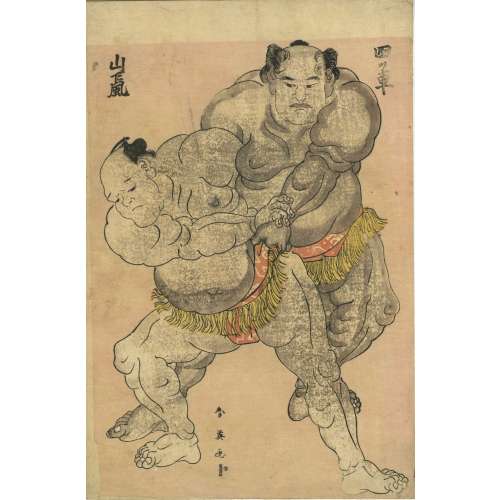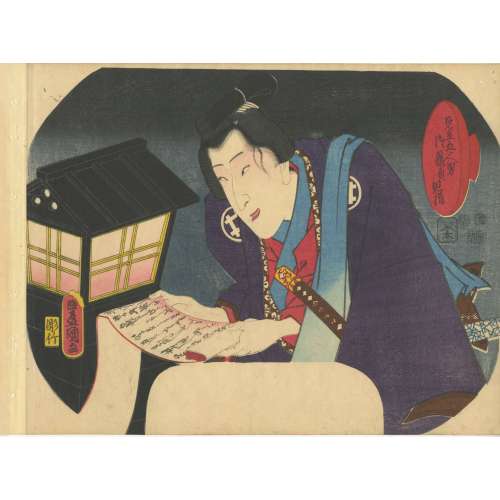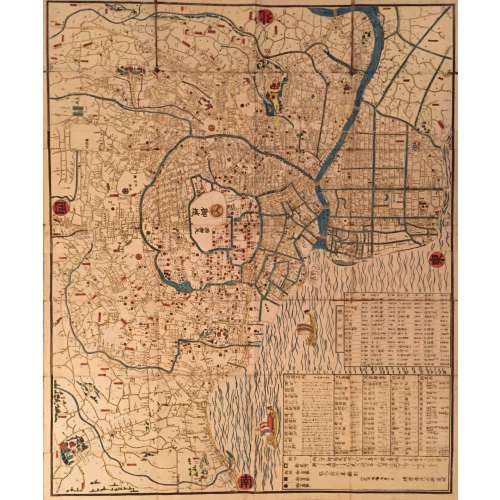References:
Jacob Pins #547 [p.217] - Ebisu drawing wakamizu, the first water drawn from a well on the New Year. TNM II (Tokyo National Museum Catalogue vol. 2) #1373.

References:
Jacob Pins #547 [p.217] - Ebisu drawing wakamizu, the first water drawn from a well on the New Year. TNM II (Tokyo National Museum Catalogue vol. 2) #1373.


Kitagawa Tsukimaro (Kikumaro): 喜多川 月麿, fl. c. 1794–1836.
Mother is playing with her child: they left playing with shadow lantern for freeing a turtle (Hojo-e, or "Rite for the Release of Living Beings").Signed: Tsukimaro hitsu (月麿筆); Publisher's mark; censor's seal: Kiwame + Yamaguchiya Tôbei gyōji seal (1811-14).




References: No references whatsoever, not in Pins.

Segawa Kikunojō III (Japanese, 1751 – 1810); other names: Segawa Senjo, Segawa Rokō III, Segawa Tomisaburō I, Ichiyama Tomisaburō, Ichiyama Shichinosuke. The actor held the name of Segawa Kikunojō III from the 11th lunar month of 1774 to the 7th lunar month of 1801. He surpassed all the actors of his time in both female and male roles, especially in the former, and achieved tremendous public acclaim.
Arashi Hinasuke II [嵐雛助] (Japanese, c. 1774 – 1801); other names: Nakamura Jūzō III, Kanō Hidenosuke I, Arashi Hidenosuke I. The actor held the name of Arashi Hinasuke II from the 1st lunar month of 1794 to the 2nd lunar month of 1801. Hi died in Edo on the 4th day of the 2nd lunar month of 1801. For the same characters illustrated by Utagawa Kuniyoshi see SVJP-0333.2021. Sources:
Sources:


 A lookalike triptych by Kunisada can be found in Ronin Gallery:
A lookalike triptych by Kunisada can be found in Ronin Gallery:
 Data from Kabuki21:
Stage names:
Matsumoto Kôshirô V, Ichikawa Komazô III, Ichikawa Sumizô I
Guild: Kôraiya
Line number: GODAIME (V)
Poetry names: Kinshô, Kinkô
Existence: 1764 ~ 10th day of the 5th lunar month of 1838
Connection:
Father: Matsumoto Kôshirô IV
Sons: Matsumoto Kôshirô VI, Ichikawa Sumizô II
Disciples: Matsumoto Kojirô, Matsumoto Kingo I, Matsumoto Hidejûrô II
Data from Kabuki21:
Stage names:
Matsumoto Kôshirô V, Ichikawa Komazô III, Ichikawa Sumizô I
Guild: Kôraiya
Line number: GODAIME (V)
Poetry names: Kinshô, Kinkô
Existence: 1764 ~ 10th day of the 5th lunar month of 1838
Connection:
Father: Matsumoto Kôshirô IV
Sons: Matsumoto Kôshirô VI, Ichikawa Sumizô II
Disciples: Matsumoto Kojirô, Matsumoto Kingo I, Matsumoto Hidejûrô II
Matsumoto Kôshirô V was one of the Kabuki giants, a senryô yakusha, during the Bunka, Bunsei and Tenpô eras. In his 20's he was a tachiyaku actor excelling in nimaime roles like Soga Jûrô Sukenari in sogamono dramas. He started to perform jitsuaku roles from the 11th lunar month of 1798 and quickly became one of the best actors for villain roles, especially in Tsuruya Nanboku IV's kizewamono. He had a considerable influence on actors like Onoe Kikugorô III or Ichikawa Danjûrô VII. The kata he deviced for some of the most famous roles in Kabuki history, like Gonta ("Sushiya") or Nikki Danjô* ("Meiboku Sendai Hagi") are still used nowadays. "The fifth Kôshirô had a very large nose and his eyes were close together, two facial defects the print artists were fond of depicting, so that this Edo actor is easily picked out in the pictures illustrating the theatre of this time." (Zoë Kincaid in "Kabuki, the Popular Stage of Japan")

 |
 |
|---|


Jacob Pins #972/p.341. Leiden, Rijksmuseum voor Volkenkunde.
"The Lovers Miura-ya Komurasaki and Shirai Gonpachi: Tragic love stories taken from real life and dramatized were a staple of stage and print; the darkly romantic combination of desire and death was hugely popular in the eighteenth century. Hirai Gompachi was a warrior of the Tottori fief in western Japan who fled to Edo after committing a murder. He was apprehended and sentenced to death in 1679. His distraught lover, the courtesan Komurasaki, committed suicide at his grave." [MET]
.

 Image from Asian Art Museum in San Francisco:
Image from Asian Art Museum in San Francisco:
Masanobu’s mitate wittily evokes an episode known as “Bodhidharma crossing the Yangzi River on a reed” (Royō Daruma). According to legend, the river crossing occurred en route to the Shaolin monastery, where Bodhidharma sat facing a wall for nine years without speaking. While serious interpretations abound in Chinese and Japanese paintings, popular prints of the Edo period often playfully substituted a beautiful woman for the monk. This parodic version was reportedly invented in response to a courtesan’s comment that she was more enlightened than Bodhidharma because she had spent ten years sitting, on display in a brothel.An interesting article about this particular design is published at UKIYO-E.ORG BLOG. Though, the design is erroneously attributed to Harunobu. We see that Bunchō was quite fascinated by the idea of crossing a water obstacle with the help of an unsuitable means of transportation:

Female Daruma Riding a Mushroom. MFA # 21.4758.

Uncut fan print (uchiwa-e), 295 x 230 mm, depicting kabuki actor Bandō Shūka I as Shirai Gonpachi (白井権八) reading a scroll by the light of a lantern. From the series A Parody of the Five Chivalrous Commoners; a Cup of Sake From Their Fans (Mitate gonin otoko, go-hiiki no omoizashi). According to Paul Griffith, the term omoizashi refers to the act of pouring a cup of sake for one's chosen partner, here giving an impression of intimacy and affection between famous actors and their patrons.
Actor: Bandō Shūka I [初代坂東しうか] (Japanese, 1813-1855); other names: Bandō Tamasaburō I, Bandō Mitsugorō V (posthumously). The print was probably published by some unknown Yama-Ta (Marks U421b). Double nanushi censor seals and date seal: Muramatsu and Fuku, Kaei 5, 2nd month (2/1852). As Kabuki Encyclopedia put it: "Gonpachi. A parasite. From the character named Shirai Gonpachi who lives at the home of Banzui Chōbei and sponges off him" (An English-Langauge Adaptation of Kabuki Jiten. Samuel L. Leiter. Greenwood Press, 1979, pp. 26, 98-9). There were many kabuki plays based on the story of the lovers Miura-ya Komurasaki and Shirai Gonpachi. (See: [LIB-2226.2019] Algernon Bertram Freeman-Mitford. Tales of Old Japan. — London: Macmillan and Co., 1883). Ref.: Art shop Ezoshi Ukiyoe new collection news, vol. 66, 2023.1 (Jan) # 31, p.8.

